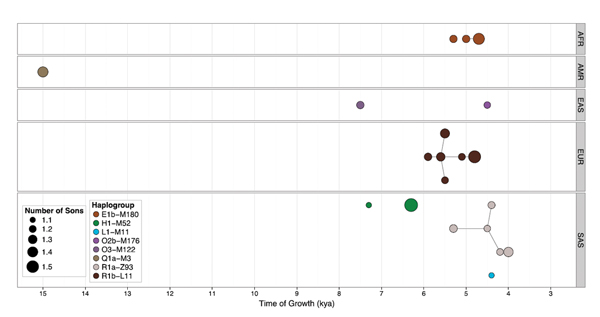Modern DNA reveals ancient male population explosions linked to migration and technology

The study, led by Dr Chris Tyler-Smith of the Wellcome Trust Sanger Institute, analysed sequence differences between the Y chromosomes of more than 1200 men from 26 populations around the world using data generated by the 1000 Genomes Project.
The work involved 42 scientists from four continents.
“We identified more than 60,000 positions where one DNA letter was replaced by another in a man with modern descendants, and we discovered thousands of more complex DNA variants. These data constitute a rich and publicly available resource for further genealogical, historical and forensic studies.”
Dr David Poznik From Stanford University, California, first author on the paper
Analysing the Y chromosomes of modern men can tell us about the lives of our ancestors. The Y chromosome is only passed from father to son and so is wholly linked to male characteristics and behaviours. The team used the data to build a tree of these 1200 Y chromosomes; it shows how they are all related to one another. As expected, they all descend from a single man who lived approximately 190,000 years ago.
The most intriguing and novel finding was that some parts of the tree were more like a bush than a tree, with many branches originating at the same point.
“This pattern tells us that there was an explosive increase in the number of men carrying a certain type of Y chromosome, within just a few generations. We only observed this phenomenon in males, and only in a few groups of men.”
Dr Yali Xue Lead author from the Wellcome Trust Sanger Institute
The earliest explosive increases of male numbers occurred 50,000–55,000 years ago, across Asia and Europe, and 15,000 years ago in the Americas. There were also later expansions in sub-Saharan Africa, Western Europe, South Asia and East Asia, at times between 4,000 and 8,000 years ago. The team believes the earlier population increases resulted from the first peopling by modern humans of vast continents, where plenty of resources were available.
The later expansions are more enigmatic.
“The best explanation is that they may have resulted from advances in technology that could be controlled by small groups of men. Wheeled transport, metal working and organised warfare are all candidate explanations that can now be investigated further.”
Dr Chris Tyler-Smith From the Sanger Institute
All of the samples and data from the 1000 Genomes Project are freely available for use by other scientists and interested investigators.
More information
Publications:
Selected websites
The Wellcome Trust Sanger Institute
The Wellcome Trust Sanger Institute is one of the world’s leading genome centres. Through its ability to conduct research at scale, it is able to engage in bold and long-term exploratory projects that are designed to influence and empower medical science globally. Institute research findings, generated through its own research programmes and through its leading role in international consortia, are being used to develop new diagnostics and treatments for human disease.
The Wellcome Trust
The Wellcome Trust is a global charitable foundation dedicated to improving health. We support bright minds in science, the humanities and the social sciences, as well as education, public engagement and the application of research to medicine. Our investment portfolio gives us the independence to support such transformative work as the sequencing and understanding of the human genome, research that established front-line drugs for malaria, and Wellcome Collection, our free venue for the incurably curious that explores medicine, life and art.


